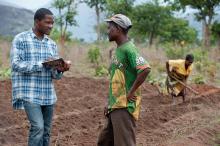Land Library
Welcome to the Land Portal Library. Explore our vast collection of open-access resources (over 74,000) including reports, journal articles, research papers, peer-reviewed publications, legal documents, videos and much more.
/ library resources
Showing items 1 through 9 of 25.The paper examines the pace of land acquisitions in terms of creating legislative and policy options to safeguard local communities that are directly affected, including compensation for land that is taken, and protecting community interests in the socio-economic and environmental continuum of in
High levels of poverty and a predominantly rural population raise questions of vulnerability to manipulation during large scale land acquisitions in Kenya.
The project aims to create actionable policy proposals to make spaces of participation more effective in five countries in Latin America, and to contribute to the needs of existing social movements within their local contexts.
Over 94 % of Nepalese migrant workers are male youth who leave their female counterparts behind to manage agriculture alongside their traditional domestic chores.
Land and associated property is a major source of individuals’ identity and livelihood.
It is widely accepted among economists and policy-makers that secure and well-defined land property rights are integral to poverty alleviation and economic prosperity. But how do legal systems, land tenure and economic development really relate to one another?
Access to land is key to achieving food security, poverty alleviation, social equity and environmental protection. A brief insight in land governance-related principles and policies of the German development assistance.
Following the end of apartheid, South Africa’s government set itself ambitious goals with a planned land reform. However, there have since been barely any changes in the country’s agricultural structure, and the positive impacts that were hoped for on rural livelihoods have hardly materialised.
Indigenous Peoples and local communities hold a large share of the world’s land area under customary systems. However, there is a tremendous gap between what is held by communities in practice and what is formally recognised by governments.








